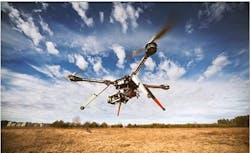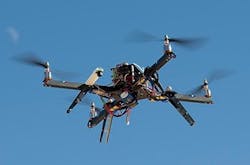Oklahoma industry, academia collaborate to advance UAS technologies, adoption, applications
UAS experts in Oklahoma are hard at work on multiple initiatives, McKeever explains, including projects funded by National Science Foundation (NSF) and U.S. Small Business Administration (SBA) contract awards, in collaboration with other UAS researchers and regional innovations clusters.
The CLOUD MAP project involves the design, development, and use of “small unmanned aerial vehicles (UAVs) to take measurements in the lower atmosphere,” McKeever describes. “That’s the hardest part, the first thousand meters. It’s that part of the atmosphere that researchers need to gather data from to study the buildup of major storms. The ultimate goal is to tell which storms will produce a tornado, and to increase the warning time from 10 to 15 minutes to at least an hour. That’s the Holy Grail, and the only way is to use a fleet of small unmanned aircraft.”
(Read “SBA Cluster Initiative award provides resources for growing UAS sector in Oklahoma, South Kansas” below for more on CLOUD MAP.)
Oklahoma is contributing the “main engineering group, which is designing the UAVs and some of the sensors for this application” and headed by Dr. Jamey Jacob, the project’s principal investigator and Ray and Linda Booker Professor of Aerospace Engineering in OSU’s College of Engineering, Architecture, and Technology (CEAT), McKeever adds. Jacobs and his team at OSU are designing the UAV, which “has got to be able to fly in the turbulent air that comes in advance of these storms and tornados,” and the integrated sensor suite to be installed on the unmanned aircraft. Weather experts at the University of Oklahoma (OU) are focused on reading the sensor data and entering the information into the prediction models, he says. “The whole team has the goal to make these UAVs and sensors read and interpret the data” to enhance weather prediction.
Federal Aviation Administration (FAA) officials have reenergized a UAS project with OSU previously put on hold, in which aerospace engineers and researchers are to use unmanned aircraft to test instrument landing systems and navigation aids at airports. “The idea is: Rather than taking out manned aircraft at airports all over the U.S. to test the instrument landing systems, we’ll develop UAVs to do the same thing.”
Oklahoma-based UAS experts also continue work on a U.S. Department of Homeland Security Phase II project focused on the use of UAS for customs and border patrol (CBP) applications. DHS officials and the CBP community are interested in evaluating commercial technologies to see how they can perform in various scenarios. Work on the project has started, with Oklahoma flying two evaluations a month, two weeks a month, McKeever describes. “After a long quiet period, during which they got the funding in place and paperwork submitted, they are now moving forward aggressively.”
“We are in a period of rapid change and modification,” McKeever concludes. “With FAA regulations around UAS, confusion is the name of the game at the moment; nevertheless, people are feeling more positive about it than they were two years ago.”
Four universities win NSF grant to develop UAS for improved weather forecasting
Researchers at the University of Oklahoma, Oklahoma State University, University of Kentucky, and University of Nebraska are developing unmanned aircraft systems (UAS) to study atmospheric physics under a four-year, $6 million grant from National Science Foundation (NSF) officials in Arlington, Virginia.
Researchers at the four universities are collaboratively developing an integrated UAS to enable the study of atmospheric physics, through which to help improve weather forecasting and precision agriculture. The project is intended to culminate in the development of small, affordable unmanned systems and a knowledge base to be used by government and university scientists, as well as private companies, to expand the understanding of atmospheric conditions and improve weather forecasting.
“Use of unmanned aircraft will eventually be a common tool in both meteorology and atmospheric physics, but there is a lot of research that needs to be accomplished first in technical, operational and regulatory areas for that to happen,” says Dr. Jamey Jacob, the project’s principal investigator and Ray and Linda Booker Professor of Aerospace Engineering in OSU’s College of Engineering, Architecture, and Technology (CEAT).
“The NSF grant solidifies the OSU College of Engineering’s impact on the unmanned aerial vehicle (UAV) industry,” says CEAT Dean Paul Tikalsky. “This is a transformative project that highlights our program’s success and innovation in the field and one that will create significant change for the future of UAV use.”
No other research using UAVs to study weather is in a position to advance the field as much as this partnership, says Daniel Fisher, professor and head of the OSU School of Mechanical and Aerospace Engineering.
The multidisciplinary team of investigators at OSU includes Girish Chowdhary and Brian Elbing from the School of Mechanical and Aerospace Engineering, and Chris Crick, computer science, and Amy Frazier, geography, as well as other OSU researchers.
“Collaboration is critical to its success,” Fisher says. “All these institutions working together creates a natural synergy, especially with the University of Oklahoma’s strength in meteorology and OSU’s expertise in building integrated UAV platforms.”
Each of the four universities brings its own unique expertise needed to make an ambitious project on this scale successful, according to Jacob. OSU brings its strength in developing unmanned aircraft and autonomous control systems together with OU’s strength in meteorology, Nebraska’s understanding of atmospheric physics and Kentucky’s development of sensor technologies and systems integration, he says.
OU will support this project through its established strengths in meteorology and radar engineering. OU has considerable experience in boundary layer meteorology and the addition of small UAS will considerably impact future studies. Additionally, OU will begin to explore the challenging question of how small UAS can be integrated into studying the impacts of climate change on our society.
“I am very excited to be part of this project because it allows us to fundamentally demonstrate the value of using small UAS to monitor and investigate the lower atmosphere,” says Phillip Chilson, professor of meteorology in the OU College of Atmospheric and Geographic Sciences and the Advanced Radar Research Center. “This research has the potential to be a real game changer for meteorology and weather forecasting.”
Currently, meteorologists primarily rely on radar and ground-based instruments that are unable to collect necessary data in the atmosphere to build better forecasting models. Weather balloons provide information but are limited by how often they can be launched. Though scientists have used large UAVs, like the Predator, to study hurricanes, the cost is prohibitive for more widespread study of atmospheric conditions.
NSF awarded the grant through its Experimental Program to Stimulate Competitive Research (EPSCoR) program as part of a national priority to increase funding and workforce development in 12 key states, including Oklahoma, in science, technology, engineering and mathematics, or science, technology, engineering, and mathematics (STEM) fields.
Along with the four universities making up the core of the collaboration, the project also involves other universities such as the University of Colorado at Boulder and the Massachusetts Institute of Technology as well as government agencies including NASA, the National Oceanic and Atmospheric Administration (NOAA), and the National Center for Atmospheric Science. Private companies are also providing expertise.
For more on the project – called CLOUD MAP for Collaboration Leading Operational UAS Development for Meteorology and Atmospheric Physics – visit http://www.cloud-map.org.
SBA Cluster Initiative award provides resources for growing UAS sector in Oklahoma, South Kansas
Unmanned aircraft systems (UAS) industry partners in Oklahoma and South Kansas are collaborating on UAS advancement under a $500,000 Cluster Initiative contract award from the U.S. Small Business Administration (SBA) in Washington.
The Oklahoma/South Kansas proposal includes 18 measurable goals, including:
- attracting technologies from federal labs and universities;
- supporting a variety of national, regional, and local events;
- mentoring and accelerator services;
- working with existing industry-related organizations;
- cataloging and developing resource guides; and
- attracting venture capital and angel investors and connecting them with entrepreneurs.
Development Capital Networks (DCN) in Oklahoma City is managing the Oklahoma/South Kansas UAS proposal, which has up to four additional years of renewal at the same amount. The Oklahoma UAS Council is providing guidance, and the Oklahoma Department of Commerce is a lead stakeholder.
“We are at the early stages of a large global industry,” explains Robert Heard, a managing director of Development Capital Networks. “We wouldn’t have this award without the talents and accomplishments of many people. This SBA contract provides great opportunities to do more, to expand our collaborations and widen our vision.”
“This SBA award is a tribute to our emerging Unmanned Aerial Systems industry,” says Dr. Steve McKeever, Oklahoma secretary of science and technology and chair of the Oklahoma UAS Council. “We have been recognized for our strong foundation and for the potential of our region to lead this industry.”
We need to use this award to bring more technology, capital, and entrepreneurs to accelerate our UAS industry,” adds Vince Howie, aerospace and defense director for the Oklahoma Department of Commerce. Howie calls the award “a great way to build on what we already have” in the industry.
Other regional partner organizations for the Cluster Initiative contract include: Cowboy Technologies Inc., the South Kansas Investing in Manufacturing Communities Partnership, and the Choctaw Nation Promise Zone.
"Clusters are public-private partnerships that are driving innovation and job creation in our most promising regional hubs," SBA Deputy Administrator Douglas Kramer describes. "SBA has built a strategic infrastructure of financing and consulting resources in key regions to help new companies launch and small companies grow, particularly in underserved communities across the country. We're unleashing the full potential of entrepreneurs who are developing cutting-edge products and processes that will help ensure American global competitiveness, creating supportive environments for small businesses in regions with the most need."
Clusters supported through the program are awarded $500,000 for the base year of the contract, with four option years to be exercised at the SBA's discretion, for up to a total of $2.5 million per cluster initiative over five years. The SBA's funding is provided to each cluster's organizing entity to strengthen opportunities for small businesses within the cluster. The funds are used to provide mentoring and counseling services, mentor-protégé and teaming programming, and to showcase and pitch events to prospective investors and public-private sector adopters of new technology.
The Unmanned Aerial Systems Cluster of South Kansas and Oklahoma has the potential for substantial amplification with SBA support, officials say. A number of local assets are in place to support this cluster, including high-level research institutions (e.g., the National Institute for Aviation Research in Wichita), well-established and relevant academic and training programs (e.g., the FAA Academy in Oklahoma City, aeronautics programs at Wichita State University and Oklahoma State University), and useful technical and facilities (including the Chilocco airspace, Camp Gruber Joint Maneuver Training Center, Clinton-Sherman Airport, Tinker Air Force Base).
This cluster initiative is also aligned with the aerospace-focused South Kansas Investing in Manufacturing Communities Partnership (IMCP) community, an Administration-wide designation which recognizes that community's commitment to and potential for contributing to a national resurgence in manufacturing. This cluster initiative has also committed to insuring the inclusion of underrepresented and underserved populations in the growing entrepreneurial ecosystem by affiliating with the Choctaw Nation Promise Zone and through outreach to tribal colleges.
For more information on the SBA's Regional Innovations Clusters, visit www.sba.gov/clusters.
You might also like:
Subscribe today to receive all the latest aerospace technology and engineering news, delivered directly to your e-mail inbox twice a week (Tuesdays and Thursdays). Sign upfor your free subscription to the Intelligent Inbox e-newsletter at http://www.intelligent-aerospace.com/subscribe.html.
Connecmct with Intelligent Aerospace on social media: Twitter (@IntelligentAero), LinkedIn,Google+, and Instagram.
Intelligent Aerospace
Global Aerospace Technology NetworkIntelligent Aerospace, the global aerospace technology network, reports on the latest tools, technologies, and trends of vital importance to aerospace professionals involved in air traffic control, airport operations, satellites and space, and commercial and military avionics on fixed-wing, rotor-wing, and unmanned aircraft throughout the world.



